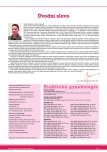-
Medical journals
- Career
Surgical techniques and legislative framework for female sterilization in the Czech Republic
Authors: Veronika Ťápalová; R. Hudeček
Authors‘ workplace: Gynekologicko-porodnická klinika, LF MU a FN Brno
Published in: Prakt Gyn 2011; 15(3-4): 197-201
Category: Review Article
Overview
Sterilization is a medical procedure that permanently inhibits fertility, while leaving the sexual glands intact. It is an effective and permanent means of birth control. Sterilization of a woman is done by surgical occlusion of the ovaries, thus preventing the sperm from getting in contact with the oocytes. History of surgical sterilization dates back to the beginning of 19th century. At present, sterilization represents 33% of all possibilities for female contraception worldwide. Surgery is usually performed by abdominal laparoscopy or, less frequently, by transcervical hysteroscopy or by dorsal vaginal vault. The tube occlusion may be surgical (cutting across, tying under), electrical (bipolar/unipolar coagulation), mechanical (application of clips, rings), chemical (tissue glues). Since, at present, sterilization is usually an irreversible approach, numerous novel methods are under development, including reversible body implants. When performed in a healthy woman who already has children and wishes not to have any more children, sterilization has no physical or psychological consequences. The benefit of this method includes the continuity of menstruation and ovulation, i.e. no effect on hormonal systems. Sterilization can also reduce the risk of ovarian cancer, probably through local disturbance of the vascular circulation, thus increasing the number of anovulatory cycles.
Key words:
sterilization – history – bipolar coagulation – transcervical hysteroscopic sterilization – Pomeroy method
Sources
1. Keller S. Female sterilization occlusion techniques. Network 1997; 18(1): 10.
2. Family Planning Worldwide: Data Sheet Bureau. 2008. Available from: http//www.prb.org/pdf08/fpds08.pdf.Data from surveys 1997–2007.
3. Campbell M, Sahin-Hoduglugil N, Potts M.Barriers to fertility regulation: a review of the literature. Stud Fam Plann 2006; 37(2): 87–98.
4. Penava D, Daskalopoulos R, Nisker J et al. Lack of timely access to tubal ligation increases risks of unintended pregnancy. Womens Health Issues 2006; 16(1): 1–3.
5. Simon H. Hysteroskopická tubární sterilizace. Komentář: Kužel D, Tóth D. Gyn po Prom 2007; 7(1): 24–27.
6. Rob L, Martan A, Citterbart K et al. Gynekologie. 2. vyd. Praha: Galén 2008 : 119.
7. Doležal A et al. Porodnické operace. Praha: Grada Publishing 2007 : 232.
8. Cibula D, Widschwendter M, Majek O et al. Tubal ligation and the risk of ovarian cancer: review and meta-analysis. Hum Reprod Update 2011; 17(1): 55–67.
Labels
Paediatric gynaecology Gynaecology and obstetrics Reproduction medicine
Article was published inPractical Gynecology

2011 Issue 3-4-
All articles in this issue
- Genetic prediction of osteoporosis in clinical practice
- Prevention of postpartum hemorrhage in caesarean section with carbetocin
- Applications of GnRH analogues in infertility treatment
- Targeted – biological treatment of ovarian cancer
- Sperm analysis by fluorescence in situ hybridization
- Preventing hereditary risk of breast and ovarian cancer
- Sayana – the new face of the traditional depot medroxyprogesterone acetate
- Caesarean section – with what anaesthesia?
- Management of recurrent ovarian cancer
- Spontaneous abortions in Slovakia from 1997 to 2009
- The reasons for severe ovarian hyperstimulation syndrome in patients requiring hospitalisation
- Surgical techniques and legislative framework for female sterilization in the Czech Republic
- Cornual pregnancy carried to full term
- Prolapsus uteri at vaginae totalis with Mayer’s pessary
- 13th World Congress on Menopause
- Aromatase inhibitors in breast cancer: review and possible benefits in premenopausal women
- Practical Gynecology
- Journal archive
- Current issue
- Online only
- About the journal
Most read in this issue- Prolapsus uteri at vaginae totalis with Mayer’s pessary
- Applications of GnRH analogues in infertility treatment
- Cornual pregnancy carried to full term
- The reasons for severe ovarian hyperstimulation syndrome in patients requiring hospitalisation
Login#ADS_BOTTOM_SCRIPTS#Forgotten passwordEnter the email address that you registered with. We will send you instructions on how to set a new password.
- Career

